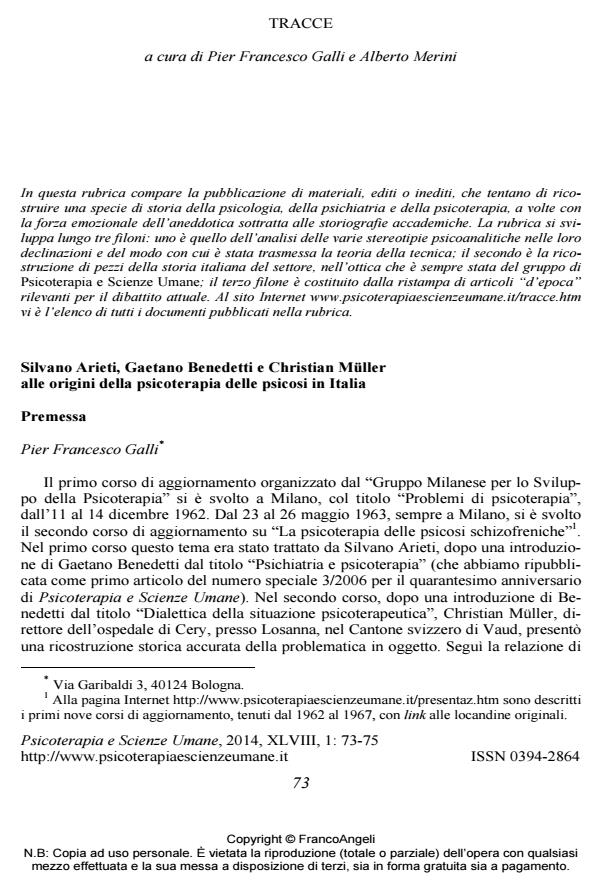Psychodynamics and psychotherapy of schizophrenic psychoses
Journal title PSICOTERAPIA E SCIENZE UMANE
Author/s Pier Francesco Galli, Silvano Arieti
Publishing Year 2014 Issue 2014/1
Language Italian Pages 38 P. 73-110 File size 505 KB
DOI 10.3280/PU2014-001004
DOI is like a bar code for intellectual property: to have more infomation
click here
Below, you can see the article first page
If you want to buy this article in PDF format, you can do it, following the instructions to buy download credits

FrancoAngeli is member of Publishers International Linking Association, Inc (PILA), a not-for-profit association which run the CrossRef service enabling links to and from online scholarly content.
A lecture given by Silvano Arieti (1914-1981) on December 11, 1962, in Milan at a training course on "Problems of psychotherapy" is reprinted. This course was organized by the "Milan Group for the Advancement of Psychotherapy" (that later took the name of Psicoterapia e Scienze Umane). Arieti’s lecture is preceded by an introduction of Pier Francesco Galli (who organized that course) and divided in two parts, each followed by the transcription of the discussions held at the time among the participants (a total of 22 interventions). Arieti describes his psychotherapeutic technique for schizophrenia, emphasizing the differences from the techniques of - among others - Frieda Fromm-Reichmann, Marguerite Sechehaye, John Rosen and the existentialist approaches. In particular, Arieti talks of his technique for hallucinations and delusions, the process of "concretization" in schizophrenic thought, drug therapy, relationship with families, outcome criteria, treatment termination, and so on.
Keywords: Schizophrenia, psychodynamic therapy of schizophrenia, concretization in schizophrenic thought process, hallucinations, interpretation of schizophrenia
- Arieti S. (1955). Interpretation of Schizophrenia. New York: Robert Brunner (trad. it.: Interpretazione della schizofrenia. Milano: Feltrinelli, 1963).
- Arieti S., editor (1959-66). American Handbook of Psychiatry (3 volumi). New York: Basic Books (trad. it.: Manuale di psichiatria. Tre volumi. Torino: Boringhieri, 1969-70).
- Arieti S. (1976). Creativity: The Magic Synthesis. New York: Basic Books (trad. it.: Creatività. La sintesi magica. Roma: Il Pensiero Scientifico, 1979).
- Domarus von E. (1944). The specific laws of logic in schizophrenia. In: Kasanin J.S., editor, Language and Thought in Schizophrenia. New York: Norton, 1944, pp. 104-114.
- Federn P. (1953). Ego Psychology and the Psychoses. New York: Basic Books.
- Freud S. (1899 [1900]). L’interpretazione dei sogni. Opere, 3. Torino: Boringhieri, 1966.
- Freud S. (1937). Costruzioni nell’analisi. Opere, 11: 541-552. Torino: Boringhieri, 1979.
- Fromm-Reichmann F. (1950). Principles of Intensive Psychotherapy. Chicago, IL: University of Chicago Press (trad. it.: Princìpi di psicoterapia. Milano: Feltrinelli, 1961).
- Fromm-Reichmann F. (1959). Psychoanalysis and Psychotherapy. Selected Papers of Frieda Fromm-Reichmann (Bullard D.M., editor). Chicago, IL: University of Chicago Press (trad. it.: Psicoanalisi e psicoterapia. Milano: Feltrinelli, 1964).
- Goldstein K. (1934). Der Aufbau des Organismus. Einführung in die Biologie unter besonderer Berücksichtigung der Erfahrungen am kranken Menschen. Den Haag: Nijhoff (trad. it.: L’organismo: un approccio olistico alla biologia derivato dai dati patologici nell’uomo. Introduzione di Oliver Sacks. Roma: Fioriti, 2010).
- Goldstein K. & Scheerer M. (1941). Abstract and Concrete Behavior: An Experimental Study With Special Tests. Psychological Monographs (Dashell J.F., editor), 53, 2 (239): 1-151.
- Jung C.G. (1907). Psicologia della dementia praecox. In: Opere di Carl G. Jung, Vol. 3: Psicogenesi delle malattie mentali. Torino: Boringhieri, 1971, pp. 9-158.
- Lamarck J.-B. (1809). Philosophie zoologique. Paris: Schleicher (trad. it.: Filosofia zoologica. Firenze: La Nuova Italia, 1976).
- Odier C. (1948). L’angoisse et la pensée magique. Neuchâtel: Delachaux & Niestlé (trad. it.: L’angoscia e il pensiero magico: analisi psicogenetica della fobia e della nevrosi d’abbandono. Firenze: Giunti-Barbera, 1975).
- Piaget J. (1964). Six etudes de psychologie. Geneve: Denoel-Gonthier (trad. it.: Lo sviluppo mentale del bambino e altri studi di psicologia. Torino: Einaudi, 1964).
- Piaget J. & Inhelder B. (1966). La psychologie de l’enfant. Paris: PUF (trad. it.: La psicologia del bambino. Torino: Einaudi, 1970).
- Rosen J.N. (1953). Direct Analysis: Selected Papers. New York: Grune & Stratton.
- Sechehaye M.H. (1947). La réalisation symbolique: nouvelle méthode de psychothérapie appliquée à un cas de schizophrénie. Revue Suisse de Psychologie et de la Psychologie Appliquée, Suppl 12. Berne: Huber (trad. inglese: Symbolic Realization. New York: International Universities Press, 1951).
- Sechehaye M.H. (1950). Journal d’une schizophrène. Paris: PUF (trad. it.: Diario di una schizofrenica. Presentazione di Cesare L. Musatti. Firenze: Giunti Barbera, 1955). Si veda anche il film di Nelo Risi del 1968 Diario di una schizofrenica.
- Sechehaye M.H. (1955). Le transfert dans la réalisation symbolique. Revue Française de Psychanalyse, 1956, 20, 4: 479-493 (trad. inglese: The transference in symbolic realization. International Journal of Psychoanalysis, 37: 270-277).
- Sechehaye M.H. (1956). La réalisation symbolique, un catalyseur de la structuration du Moi schizophrénique. In: Müller Ch. & Benedetti G., editors, Ier Symposium international sur la Psychothérapie de la Schizophrénie (Lausanne, octobre 1956). Basel: Karger, 1957, pp. 274-296 (http://www.karger.com/Article/PDF/285276).
- Sechehaye M.H. (1960). Technique de gratification en psychothérapie analytique. Évolution Psychiatrique, 25, 3: 297-382, 4: 559-584.
- Siirala M. (1969). Medicine in Metamorphosis: Speech, Presence and Integration. London: Tavistock (trad. it.: Parola, presenza e integrazione: medicina in metamorfosi. Milano: Feltrinelli, 1971).
- Tracce Glauco Carloni, Pier Francesco Galli, Silvia Montefoschi, Mara Selvini Palazzoli, in PSICOTERAPIA E SCIENZE UMANE 3/2014 pp.471
DOI: 10.3280/PU2014-003007 - Fra storia e natura: la psichiatria antiriduzionista di Silvano Arieti Roberta Passione, in RICERCHE DI PSICOLOGIA 2/2016 pp.153
DOI: 10.3280/RIP2016-002002 - Alcune pubblicazioni di Pier Francesco Galli elencate in ordine cronologico A cura della Redazione, in PSICOTERAPIA E SCIENZE UMANE 3/2024 pp.419
DOI: 10.3280/PU2024-003003
Pier Francesco Galli, Silvano Arieti, Silvano Arieti, Gaetano Benedetti e Christian Müller alle origini della psicoterapia delle psicosi in Italia. Premessa. Psicodinamica e psicoterapia delle psicosi schizofreniche (1962) in "PSICOTERAPIA E SCIENZE UMANE" 1/2014, pp 73-110, DOI: 10.3280/PU2014-001004